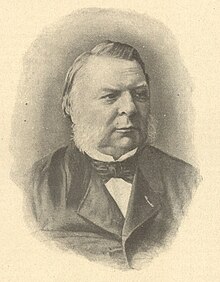Karl Wilhelm Scheibler
Karl Wilhelm Scheibler | |
|---|---|
 Karl Wilhelm Scheibler | |
| Born | 1 September 1820 |
| Died | 13 April 1881 (aged 60) |
| Nationality | German, Polish |
| Occupation(s) | Industrialist, textile magnate |


Karl Wilhelm Scheibler (Polish: Karol Scheibler, 1 September 1820 – 13 April 1881) was a German-born Polish industrialist, businessman and textile manufacturer.[1]
Biography
Scheibler was born in Montjoie (today
Because of the riots of the
In 1855, Scheibler founded a spinning mill with 34 frames and a steam engine of 40 horsepower. In 1857, Scheibler employed 180 labourers and earned a turnover of 305,100 rubles in 1860. Scheibler made large profits after cotton prices in Europe increased because of the American Civil War and sold his stock at triple the price.[4] He became known as the "King of the Cotton and Linen Empires of Łódź".[5] In 1870, 1,911 employees worked in his factory, which was the third largest (9.3 percent) cotton producer of Poland.
Scheibler's factory continued to prosper and he bought several smaller mills in the districts of Źarki and Księży Młyn. After a fire destroyed the factory at Księży Młyn in 1874, Scheibler rebuilt it with 88.000 spindles and built his own "Kingdom" of Księży Młyn with houses for 321 families, a fire station, schools, shops and a hospital
In 1880, he transformed his enterprise into a stock corporation with a share capital of 9 million Ruble.[10]
Scheibler died on 13 April 1881 in Łódź and was buried at the
Awards
- 1870 Order of the White Eagle[1]
- 1876 Gold Medal in Warsaw
- 1878 Great Gold Medal at the Paris World's Fair
- Order of Saint Stanislaus First and Second class
Cultural associations
The figure of the German industrialist Heinz Huntze, a character of The Brothers Ashkenazi, is loosely based on Karl Wilhelm Scheibler.
References
- ^ a b Aufbau und Entwicklung der Lodzer Textilindustrie (in German). Otto Heike. 1971. Retrieved 2009-10-02.
- ^ findagrave
- ISBN 9783598250385. Retrieved 2009-10-02.
- ^ a b EUbuildit Archived 2011-06-05 at the Wayback Machine
- ^ a b "Łódź in the Post-communist Era: In Search of a New Identity" (PDF). Joanna B. Michlic. Stockton University. Archived from the original (PDF) on 2010-06-30. Retrieved 2009-10-02.
- ^ migrationsroute.nrw.de Archived 2011-07-19 at the Wayback Machine(in German)
- ^ Biography
- ^ History of the Bank Handlowy Archived 2011-10-09 at the Wayback Machine (in Polish)
- ^ Biography at State archive Łódź Archived 2009-09-18 at the Wayback Machine (in Polish)
- ^ Urząd Miasta Łódź, Księży Młyn, Łódź 1998, p. 23 (in Polish)
External links
- Scheibler's palace at Łódź[permanent dead link] (in Polish)
- Kinomuzeum.pl showing some inside views of Scheibler's Palace
